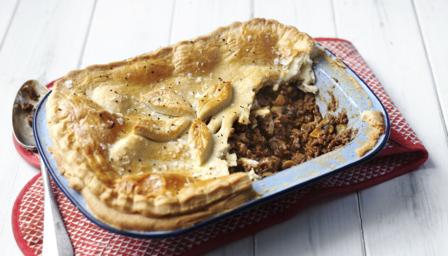
English recipes from the Middle Ages describe a mixture of meat and fruit and included vinegars and wines, and by the 18th Century distilled spirits like brandy were used. But the tradition goes back much further than that. Mincemeat became associated with Christmas when the Crusaders returned home in the 12th Century bringing with them spices from the Middle East: cinnamon, cloves, and nutmeg. Those three spices were symbolic of the three gifts of the Magi given to the Christ Child. The spices also happened to contain antimicrobial properties that helped preserve the meat. They also no doubt masked any flavors of old meat. Mincemeat Pie, sometimes referred to as Shred Pie, Mutton Pie and Christmas Pye, was baked during the Christmas season and was originally shaped in the form of a cradle, another reminder of the birth of Jesus. They were not very large and it was considered good luck to eat one on each of the twelve days of Christmas that concluded on Epiphany.

But over the years and centuries things began to change. The shape was modified from oblong to round and the meat content was gradually reduced. Thus mincemeat pie was less of a savory dinner course and more of a dessert offering. In England Oliver Cromwell, the self-proclaimed Lord Protector of the Kingdom abolished the celebration of Christmas all together in 1657. His decree forbade the consumption of mincemeat pies which he considered a guilty, forbidden pleasure. Fortunately at his coronation in 1660 King Charles II restored Christmas festivities. But the edict had already spread to some of the Colonies and Christmas was banned in Boston from 1659 until 1681. Those caught celebrating the holiday during that time were fined.
By the 20th Century beef suet had replaced the meat, and fruits took center stage. And it is not uncommon to find contemporary versions that lack any meat or suet at all. In her diatribe against such a practice Lauren G. Fink in her essay Old World Christmas Pie writes:
"Modern day mincemeat pie contains no meat, sometimes no alcohol, and is a wimpy salute to the manly, beefy pie of mincemeat history. The real thing comprises several classic Christmas elements --goose, venison, or beef, seasoned apples, dried fruit, cider, molasses, and candied peel -- diced, spiced, and doused in brandy, then baked in a golden crust."
If you would like to make your own mincemeat pie, be aware that the list of ingredients is formidable, but the end result will be worth the effort and you will then be a part of a long standing Christmas culinary tradition.

No comments:
Post a Comment